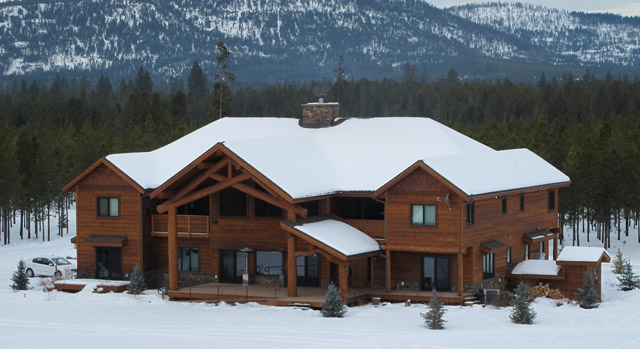Pilot Briefing
News from the world of general aviation
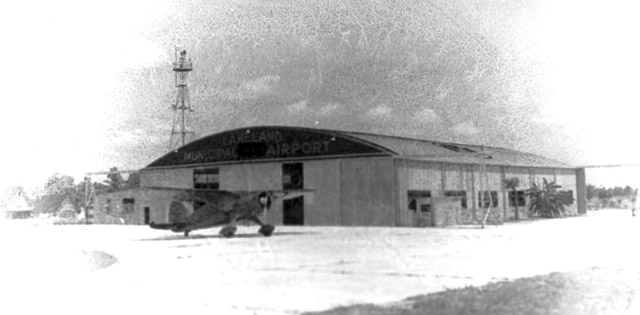 A single-engine aircraft is parked in front of a hangar at Lakeland Municipal Airport in Lakeland, Florida, circa 1937. Lakeland Municipal Airport opened on Lakeland Hills Boulevard in 1935. In 1940 the city leased the airport to the Lakeland (later Lodwick) School of Aeronautics to train pilots for service in World War II. After the war, the site reverted to the city and continued to be used as an airport for several years. It is now Tiger Town, the spring training home of Major League Baseball's Detroit Tigers. Courtesy Lakeland Public Library.
A single-engine aircraft is parked in front of a hangar at Lakeland Municipal Airport in Lakeland, Florida, circa 1937. Lakeland Municipal Airport opened on Lakeland Hills Boulevard in 1935. In 1940 the city leased the airport to the Lakeland (later Lodwick) School of Aeronautics to train pilots for service in World War II. After the war, the site reverted to the city and continued to be used as an airport for several years. It is now Tiger Town, the spring training home of Major League Baseball's Detroit Tigers. Courtesy Lakeland Public Library.
The little airport that could
Now home to Sun ’n Fun
By Kevin Garrison
Lakeland Linder Regional Airport in Lakeland, Florida, is known to today’s pilots as the home of the Sun ’n Fun International Fly-In and Expo held every spring. The airport was first named Drane Field, and it was used during World War II as an advanced bomber and fighter training base. However, the airport was designated “airport number two” when it was built—the original Lakeland Municipal Airport was located on the north side of town; today the Detroit Tigers hold spring baseball training on the site each year.
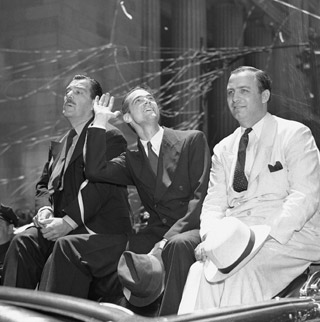 Lakeland Municipal was also known as Lodwick Field. It was named for Albert Lodwick, who worked for the Curtiss-Wright Corporation and from 1938 through 1941 was president of the Stinson Aircraft Corporation. Lodwick managed Howard Hughes’ successful 91-hour around-the-world flight in July 1938. Courtesy Corbis.
Lakeland Municipal was also known as Lodwick Field. It was named for Albert Lodwick, who worked for the Curtiss-Wright Corporation and from 1938 through 1941 was president of the Stinson Aircraft Corporation. Lodwick managed Howard Hughes’ successful 91-hour around-the-world flight in July 1938. Courtesy Corbis.
Lakeland played a major role in Britain’s war effort at the beginning of World War II when the United States was still neutral. In early 1941, based on the Lend-Lease Program, British pilots needed a quiet place to train. The little town of Lakeland, with a population of a little less than 25,000, suddenly faced an influx of thousands of young American men and an almost equal number of British pilot candidates. In the early 1940s the sound of dozens of aircraft was constantly in the air over Lakeland. Hundreds of airplanes buzzed about to the north and to the south, at the new Drane Field, were heard the rumble of B–24s and other bombers and the growl of fighter aircraft. The main trainer used in Lakeland and other schools was the Stearman PT–17, although a smaller number of Ryans and Fairchilds were used as well.
This influx of men, machines, and the things necessary to support a flight school that large had a major impact on Lakeland that lasts through today. The military provided the airplanes, the student pilots, and a cadre of officers to oversee the military side of things—but it did not provide mechanics, instructors, cooks, doctors, nurses, and other specialists. This left the local population to take up the slack. Hundreds of aircraft mechanics, both male and female, were trained and used during this time. The postwar airline and automobile boom was fueled largely by formerly rural people who had been trained during the war.
The Sun ’n Fun International Fly-In and Expo takes place April 9 through 14, 2013.
DEBONAIR SWEEPSTAKES PROGRESS REPORT
Avionics home stretch
Strapping on the electrons
By Thomas A. Horne
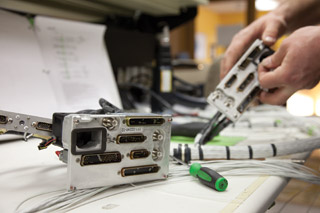 A lot of the panel work involves painstaking attention to detail in making new wiring bundles and connectors. All of the 50-year-old wiring has been replaced with brand-new leads.
A lot of the panel work involves painstaking attention to detail in making new wiring bundles and connectors. All of the 50-year-old wiring has been replaced with brand-new leads.
By the time you read this, the AOPA sweepstakes Debonair should be making its way to the Sun ’n Fun International Fly-In and Expo at Lakeland Linder Regional Airport. That event will run from April 9 through April 14, and it will be the first time the public will get a close-up look at this remarkable airplane.
As this issue goes to press, Santa Fe Aero Services is busy installing the many new components in the Debonair’s panel. Topping that list is Aspen Avionics’ three-screen Evolution 2500 display system; Garmin’s GTN 750 and GTN 650 GPS/navcoms; Electronics International’s MVP-50P engine and systems analyzer; Alpha Avionics’ angle-of-attack indicator; R.C. Allen’s standby attitude indicator; CO Guardian’s combination carbon monoxide detector/clock/cabin altitude alerter; PS Engineering’s PMA 8000BT audio panel; and an iPad capable of receiving ADS-B-In data from Garmin’s GDL 39 GPS and datalink antenna. Other sources of ADS-B information—both traffic and weather—will come from Garmin’s GDL 88 dual-channel datalink receiver.
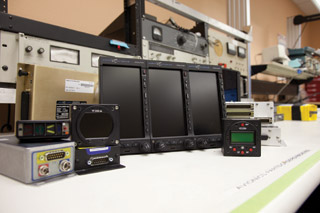 The new panel will be dominated by Aspen Avionics’ three-screen, Evolution 2500 display system.
The new panel will be dominated by Aspen Avionics’ three-screen, Evolution 2500 display system.
Of course, that’s not all that’s aboard. National AirParts Inc. provided a new, 70-amp alternator conversion. Wentworth Aircraft supplied a new alternator bracket to replace the earlier bracket, which failed. All those new avionics will require more than the 55 ampere/hours that the previous unit put out, so the National AirParts upgrade was a necessity. Electrical power increases are not new to the Debonair line. Early models came with 35-amp Bendix generators, which weren’t sufficient from the start, according to National AirParts’ Al Petrone. So, many owners opted to move up to 55-amp Alcor alternators, one of which was in the Debonair when it was purchased. During one flight, that alternator’s bracket failed in two places, causing the alternator belt to slip. This made power output sink to the point where the landing-gear motor (the gear system is all-electric) didn’t have enough oomph to retract the gear on one occasion! So it’s good riddance to that wimpy bracket.
In addition to these updates in AOPA Pilot, there is blog coverage of the Debonair sweepstakes project in the “Sweepstakes Logbook” section of AOPA’s website, and I’d encourage you to check the site frequently for more news. Just go online, scroll down the left side of the homepage until you get to the “Blogs” section, and click away. We’ve posted slideshows of the work being done on the airplane under the “Sweeps Home” button on the logbook page, and videos will be posted there as well. AOPA’s weekly webcast—AOPA Live This Week—also features stories on the Debonair’s progress. Before long, you’ll be seeing videos of yours truly flying the newly embellished panel, with in-flight demonstrations of all its capabilities. I can’t wait.
Email [email protected].
PILOT PRODUCTS
Looking good
High-end accessories
Compiled by Ian J. Twombly
Flying Eyes Sunglasses
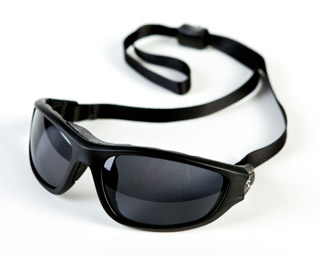 One of the drawbacks to noise-canceling headsets is they require a nearly perfect ear seal to work—and wearing sunglasses can easily break that seal. Flying Eyes Sunglasses are intended to address that shortcoming, designed for comfortable wear under headsets on long flights. Flying Eyes’ solution is to replace the rigid over-ear portion of its glasses with a thin, adjustable head strap, which can be tightened or loosened with a rear slide so that it fits securely. And if the wearer wants to go back to the traditional folding, over-ear frames for ground use, installing them takes only a few seconds.
One of the drawbacks to noise-canceling headsets is they require a nearly perfect ear seal to work—and wearing sunglasses can easily break that seal. Flying Eyes Sunglasses are intended to address that shortcoming, designed for comfortable wear under headsets on long flights. Flying Eyes’ solution is to replace the rigid over-ear portion of its glasses with a thin, adjustable head strap, which can be tightened or loosened with a rear slide so that it fits securely. And if the wearer wants to go back to the traditional folding, over-ear frames for ground use, installing them takes only a few seconds.
I flew with Flying Eyes sunglasses on two stunningly sunny afternoons and found them almost ideal for aviation. Designer Dean Siracusa is an experienced GA pilot, and he optimized this product for cockpit use. The glasses don’t interfere with noise canceling headsets; the lenses are not polarized, so glass-panel avionics remain readable; they can be customized for bifocals; and the wraparound form allows almost no peripheral light to leak in and cause unwanted reflections. For pilots who fly in windy, open-cockpit airplanes or especially loud cockpits, Flying Eyes are just about perfect.
The only thing I don’t like about the head strap design is that it makes putting the glasses on and taking them off a bit cumbersome. Until wearing the head strap, I didn’t realize how often I put sunglasses on, take them off, and lift them up to peek around them. You can partially get around this by leaving the strap slightly loose and raising the glasses as necessary.
Also, at nearly $180, Flying Eyes aren’t inexpensive. One possible way to reduce the cost is to eliminate the rigid, over-ear frames altogether. I have a hard enough time keeping track of my sunglasses that there’s little chance of keeping a pair of sunglasses together with two over-ear pieces and a head strap. Since the head strap does so well in the cockpit, I’d just stick with it all the time.
Contact: www.flyingeyes.biz
Price: $179— Dave Hirschman
Scheyden Mustang sunglasses
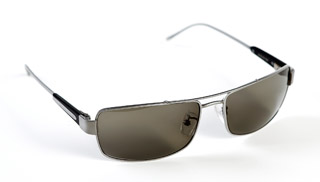 Scheyden has long been known to make great sunglasses for aviation, but the Mustang, one of the company’s latest models, is probably its best. Featuring a titanium frame and mineral-glass lenses, the Mustangs are light, strong,
Scheyden has long been known to make great sunglasses for aviation, but the Mustang, one of the company’s latest models, is probably its best. Featuring a titanium frame and mineral-glass lenses, the Mustangs are light, strong,
and scratch resistant.
The style is reminiscent of the classic square shape of Randolph Aviators, but the Mustangs are much more comfortable. The design’s best feature is the wire-thin stems, which fit beautifully under a headset. We tested the Mustangs on numerous flights and found them to be incredibly comfortable. Instead of constantly taking them on and off for comfort and visibility, we just left them on through sun, under clouds, and on hazy days.
The Mustang model comes with bronze or gray lenses, in either regular or polarized. Be prepared to pay for quality, however. These horses aren’t cheap.
Contact: www.scheyden.com
Price: $309 to $349
Scottevest Fleece 7.0
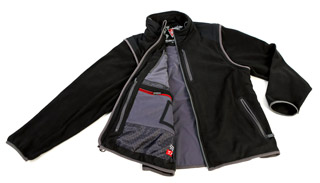 When Scottevest contacted us about a review on the Fleece 7.0, we were skeptical. We figured the Skymall Catalog regular was a bit of a gimmick. But as soon as the fleece arrived, we knew we were wrong.
When Scottevest contacted us about a review on the Fleece 7.0, we were skeptical. We figured the Skymall Catalog regular was a bit of a gimmick. But as soon as the fleece arrived, we knew we were wrong.
The Scottevest Fleece 7.0 is what James Bond would wear if he got a chill. How it’s possible to engineer so much madness into a vest, we’ll never know—but the result is brilliant. There are 23 different pockets, everywhere from the normal side pockets for hands to a compartment in the front that can hold an iPad. There are breast pockets for cellphones or a wallet, integrated pockets for earbuds, and elastic straps for a water bottle. The sleeves are removable, and there’s a clear pocket to access your cellphone without taking it out.
We wanted to know how the vest would perform as a wearable flight bag. Not surprisingly, it worked perfectly. We easily carried an iPad, fuel tester, flashlight, pens, paper, sunglasses, and ID. It can’t carry a headset, but with so much stuff hanging off your back and shoulders, you’ll actually have a free hand or two to take care of that. If you’re a gadget-obsessed pilot, the Scottevest is worth a look.
Contact: www.scottevest.com
Price: $160
Cabin Creek Landing B&B caters to pilots
A 3,400-foot airstrip in the heart of Montana
By Alyssa J. Miller
A glass of wine and an appetizer await a weary pilot checking in at the Cabin Creek Landing Bed and Breakfast in Marion, Montana, after a 15-hour cross-country. Relaxing on a leather sofa by the living room’s stone fireplace, an elk antler chandelier providing light from the vaulted ceiling, the pilot recounts the flight with B&B managers Chet and Corynne Todd. Childhood sweethearts since eighth grade, the Todds, now 25, married in May 2010, united their passion for customer service and aviation less than a year later as managers of Cabin Creek, built by Chet’s parents in 2011.
Corynne, a teacher in Marion, and Chet, a fourth-generation pilot and member of the Montana Air National Guard, help guests feel at home but are careful to respect privacy. The Todds live in an apartment connected to the B&B, and you won’t find doilies or family portraits in the lodge—just a couple of photos on the kitchen refrigerator.
Nestled on seven acres at the Cabin Creek Landing fly-in community, the two-story log cabin was built with pilots in mind. A spacious front deck overlooks the runway, perfect for watching the sun rise over the mountains, dining, or enjoying a cocktail. B&B guests are welcome to land at the paved, 3,400-foot private strip.
An eclectic mix of antiques, including a grandfather clock and pump organ; paintings and sculptures by local artists; and modern amenities give the cozy, six-room cabin an elegant resort vibe. The B&B features common and semiprivate dining areas, a workout room, four suites, and two single rooms, each with its own bath and balcony. Every detail of the rooms is designed to comfort guests: electric fireplaces, homemade cookies, plush towels, and luxurious bed linens. Singles cost $185 per night; suites $225. A $25-per-person, per-night fee is added for reservations of more than two people. There’s also a 7-percent Montana lodging tax.
The Todds cook the meals together, using family recipes to complement their breakfast dishes. One winter morning, the first course included moist banana muffins and yogurt parfait topped with caramelized pears; the second, a hearty omelet prepared to order. With a different menu every day, guests also can enjoy homemade scones, a range of breads, berries-and-cream-topped French toast, and quiche.
In the evening, guests are offered a choice of beer or wine, but the Todds are hoping to expand the selection in a small tavern on the first floor.
The B&B has cellphone reception and free Wi-Fi access, but guests can disconnect from their smartphones on hikes, bike rides, or fishing and kayaking excursions on nearby Little Bitterroot Lake (bikes and kayaks are complimentary). Horseshoes, croquet, badminton, volleyball, and bocce ball are set up in the front yard during the warmer months. The Todds also provide contact information for guests to schedule Clydesdale-drawn carriage and sleigh rides around the private airport.
Glacier National Park is a short flight to the northeast or a one-hour drive. Just 10 miles from the B&B, sports such as skydiving (Chet might be your pilot) and dogsledding are available seasonally.
Email [email protected].
Fly-outs made possible by Enterprise Rent-A-Car.
What to know more?
For more information visit the website.
Cabin Creek Airport has avgas, tiedowns, and pilot-controlled lighting.
Rental car: www.aopa.org/cars; 866-315-9155.
David Clark under pressure
What to wear to infinity and beyond
By Jim Moore
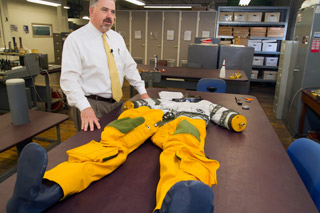 Daniel M. Barry, vice president and director of research and development for David Clark Co., and the Launch Entry Suit like the one worn by Felix Baumgartner.
Daniel M. Barry, vice president and director of research and development for David Clark Co., and the Launch Entry Suit like the one worn by Felix Baumgartner.
Those who dare to fly to the highest reaches of the atmosphere and beyond have a special relationship with the David Clark Co. of Worcester, Massachusetts. Headsets are assembled in what was a textile mill, and on a floor above, space suits are made—pressure suits, to be precise. Skilled workers assemble, by hand, each of the pressure suits used by U–2 pilots throughout the aircraft’s long history, turning out four of those a month. Seams are stitched to exacting tolerances: plus 1/64 inch (less than the needle’s diameter), minus zero.
When STS-1 Commander John Young lifted off aboard the Space Shuttle Columbia’s maiden voyage in 1981, he was wearing a David Clark partial pressure suit: the Launch Entry Suit, dubbed the “pumpkin suit” for its bright orange color, designed to save the lives of the crew had they ejected (early missions were equipped with ejection seats). It was an adaptation of a suit long proven in the SR–71 Blackbird, as well as past NASA missions. Austrian skydiver “Fearless” Felix Baumgartner jumped from nearly 128,000 feet on October 14, 2012, and broke the sound barrier (reaching Mach 1.25) wearing a David Clark suit, a full pressure version customized for the Red Bull Stratos mission.
Daniel M. Barry, vice president and director of research and development for David Clark Co., said the particular challenge of such a high altitude—aside from the fact that a person’s blood would boil more or less instantly in case of a breach—is that a flat spin can kill. With so little air to offer resistance, no one was certain Baumgartner would be able to control his initial descent. There were safeguards: a drogue chute would automatically deploy beyond preset G-force limits, for example. Baumgartner visited the mill for a personal fitting; his suit was modified to maximize freedom of movement of arms and legs, allowing the skydiver to exercise what control he could.
Flat spin he did, but Baumgartner brought it under control. The data gathered will help in the design of a new generation of “escape” suits designed for reentry, and make it possible for astronauts—including the coming generation of well-heeled space tourists lining up for suborbital flights—to get out if the flight goes wrong.
A prototype of a new offering from the company is a coffee-colored Contingency Hyperbaric Astronaut Protection Suit, or CHAPS. “You have to wear something,” Barry said.
Email [email protected].
LoPresti Aviation shifts focus, Fury on hold
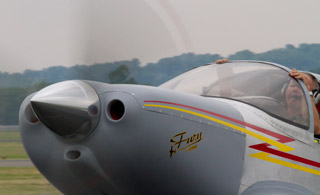 LoPresti Aviation has put development of its two-seat Fury on hold for 2013 while the company’s new management shifts focus toward lights designed for the business jet market and speed mods for a broad range of general aviation aircraft.
LoPresti Aviation has put development of its two-seat Fury on hold for 2013 while the company’s new management shifts focus toward lights designed for the business jet market and speed mods for a broad range of general aviation aircraft.
Marketing Director David LoPresti said the Fury will be modified to showcase the company’s Boom Beam lighting systems, replacement fixtures designed for light aircraft and bizjets, and the company hopes to return the Fury to the airshow circuit in 2014—decked out with 10 landing lights (six facing forward, the rest lighting up the underside at various angles) to dazzle in night shows. “That’s where our business is right now, the landing and taxi light arena,” LoPresti said.
Under new CEO Tyler Wheeler, the company is closing in on a supplemental type certificate for a new cowling designed for Cessna Cardinals that is expected to boost speed by 13 mph, adding to a long list of speed modifications available for a range of GA aircraft. The Fury, designed by Roy LoPresti and originally called the Swift, may yet see the market, although plans to produce a kit are on hold. LoPresti said the company plans to produce a handful of aircraft for exhibition use, and reassess the practicality of producing kits based on market response.
SwiftFury development began at Piper Aircraft in the late 1980s. Its “comeback” was reported in AOPA Pilot in 1999.— Jim Moore
Test Pilot By Barry Schiff
- From reader Tony Bill: “I apparently was the first to pilot a heavier-than-air aircraft in controlled flight. I also was first to use the term, ‘aero plane,’ and even wrote a small book with that title. I died following a crash in an aircraft of my design, and my last words were, ‘How is the machine?’ Who am I?”
- True or False? A pilot is about to land an airplane with the right landing-gear leg and nosewheel extended but with the left landing-gear leg stuck in its well. The ailerons are equipped with conventional trim tabs that are controllable from the cockpit. During landing and rollout, the right aileron tab should be deflected fully downward.
- Why did some airmen training at Midland, Texas, during World War II have a higher incidence of black eyes than airmen training elsewhere?
- From reader Howie Lowden: How can you tell the difference between a U.S. Naval aviator and a traditional Naval officer who does not fly simply by looking at their feet?
- A pilot wants to fly a perfectly rectangular pattern while in the left traffic pattern for Runway 36 when the wind is strong and from the northeast. This requires that the radius of all turns be the same with respect to the ground. Assuming a constant airspeed throughout the pattern, the most steeply banked turn will be required when turning from
a. base to final.
b. crosswind to downwind.
c. downwind to base.
d. upwind to crosswind. - From reader Mike Piccola: True or False: Most of the American aircraft that took off from Oahu during the Japanese attack of Pearl Harbor were shot down.
- True or False: It is legal for a VFR-only pilot to fly extended distances in a small airplane above a solid undercast with no more than the instruments required for VFR flight.
- Who was the first woman in the United States to become a licensed glider pilot?
See answers below >>
Mark your calendars
AOPA Summit takes place in Fort Worth, Texas, October 10-12. Registration opens in April.
Test Pilot Answers
- “I am glider pioneer, designer, and pilot John J. Montgomery. My first controlled flight carried me 600 feet over the Otay Mesa near San Diego on August 28, 1883. The high-wing monoplane in which I perished on October 17, 1911, was of my design and powered by an engine provided by Victor Loughead [later Lockheed].”
- False: The tab should be up on the right aileron and down on the left. Although such “left roll trim” requires more muscle to hold the wheel or stick to the right, the tabs work with and not against the ailerons, which makes them more effective at holding up the left wing at low speed.
- The Army’s largest bombardier school was in Midland. The sooty, soft-rubber eyepieces of the bombsights left black circles around the eyes of student bombardiers.
- Naval personnel associated with aviation wear brown shoes, while traditional personnel associated with anything else wear black shoes.
- (b) There are two reasons for this. The groundspeed and the required heading change are greatest when turning from the crosswind leg to the downwind leg (in this case). You can confirm this by sketching such a rectangular course and showing the crab direction on each leg.
- False. Of the 390 U.S. aircraft on Oahu on December 7, 1941, 38 took off and 10 were shot down.
- True. This demonstrates that what is legal is not necessarily safe.
- Anne Morrow Lindbergh obtained her glider license in 1930 while on honeymoon in San Diego with her famous husband, Charles.
